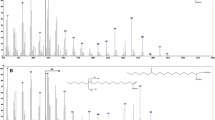Abstract
Outer and cytoplasmic membranes ofPseudomonas pertucinogena ATCC 190 and 6627 were separated, and their lipids were analyzed. In the two strains, phosphatidylethanolamine was dominant in the cytoplasmic membrane, but cardiolipin and phosphatidylglycerol were dominant in the outer membrane. Various kinds of fatty acids, namely, odd- and evennumbered, saturated and unsaturated, branched, and cyclopropanoic acids were contained in these strains. Only in strain 190 were unsaturated fatty acids increased in the cytoplasmic membrane, but saturated fatty acids were increased in the outer membrane. Fatty acid distribution to the outer and cytoplasmic membranes in strain 6627 was similar. In the two strains, lysocardiolipin appeared from the early exponential phase of growth and was present at a level eight times higher in the cytoplasmic membrane than in the outer membrane, although phospholipase A activity was located mainly in the outer membrane. From these results, the possibility of the presence of lysocardiolipin as a normal phospholipid constituent of the membrane was discussed.
Similar content being viewed by others
Literature Cited
Bartlett, G. R. 1959. Phosphorus assay in column chromatography. Journal of Biological Chemistry234:466–468.
Bligh, E. G., Dyer, W. J. 1959. A rapid method of total lipid extraction and purification. Canadian Journal of Biochemistry and Physiology37:911–917.
Kates, M. 1964. Bacterial lipids. Advances in Lipid Research2:17–90.
Kawai, Y. 1974. Purification and characterization of pertucin produced byPseudomonas pertucinogena. Antimicrobial Agents and Chemotherapy6:347–359.
Kawai, Y., Moribayashi, A. 1978. Taxonomic implications of the lipid composition ofPseudomonas pertucinogena.
Kawai, Y., Moribayashi, A. 1982. Characteristic lipids ofBordetella pertussis: simple fatty acid composition, hydroxy fatty acids, and an ornithine-containing lipid. Journal of Bacteriology151:996–1005.
Kawai, Y., Yabuuchi, E. 1975.Pseudomonas pertucinogena sp. nov., an organism previously misidentified asBordetella pertussis. International Journal of Systematic Bacteriology25:317–323.
Lowry, O. H., Rosebrough, N. J., Farr, A. L., Randall, R. J. 1951. Protein measurement with the Folin phenol reagent. Journal of Biological Chemistry193:265–275.
Marr, A. G., Ingraham, J. L. 1962. Effect of temperature on the composition of fatty acids inEscherichia coli. Journal of Bacteriology84:1260–1267.
Mizuno, T., Kageyama, M. 1978. Separation and characterization of the outer membrane ofPseudomonas aeruginosa. Journal of Biochemistry84:179–191.
Mulder, E., Van Deenen, L. L. M. 1965. Metabolism of redcell lipids. III. Pathways for phospholipid renewal. Biochimica et Biophysica Acta106:348–356.
Osborn, M. J., Gander, J. E., Parisi, E., Carson, J. 1972. Mechanism of assembly of the outer membrane ofSalmonella typhimurium: isolation and characterization of cytoplasmic and outer membrane. Journal of Biological Chemistry247:3962–3972.
Oshima, M., Miyagawa, A. 1974. Comparative studies on the fatty acid composition of moderately and extremely thermophilic bacteria. Lipids9:476–480.
Proulx, P. R., Van Deenen, L. L. M. 1966. Acylation of lysophosphoglycerides byEscherichia coli. Biochimica et Biophysica Acta125:591–593.
Shaw, N. 1974. Lipid composition as a guide to the classification of bacteria. Applied Microbiology17:63–105.
Sinensky, M. 1971. Temperature control of phospholipid biosynthesis inEscherichia coli. Journal of Bacteriology106:449–455.
Thiele, O. W., Schwinn, G. 1973. The free lipids ofBrucella melitensis andBordetella pertussis. European Journal of Biochemistry34:333–334.
Tomiyasu, I. 1982. Mycolic acid composition and thermally adaptative changes inNocardia asteroides. Journal of Bacteriology151:828–837.
Toriyama, S., Yano, I., Masui, M., Kusunose, E., Kusunose, M., Akimori, N. 1980. Regulation of cell wall mycolic acid biosynthesis in acid-fast bacteria.
Torregrossa, R. E., Makula, R. A., Finnerty, W. R. 1977. Characterization of lysocardiolipin fromActinetobacter sp. sp. H01-N. Journal of Bacteriology131:486–492.
Van Deenen, L. L. M., Haas, G. H. 1966. Phosphoglycerides and phospholipases. Annual Review of Biochemistry35:157–194.
Webster, G. R. 1965. The acylation of lysophosphatides with long-chain fatty acids by rat brain and other tissues. Biochimica et Biophysica Acta98:512–519.
Author information
Authors and Affiliations
Rights and permissions
About this article
Cite this article
Kawai, Y., Shintani, M. Difference in lipids between two similar strains ofPseudomonas pertucinogena and possibility of the presence of lysocardiolipin as a normal phospholipid constituent of its membrane. Current Microbiology 9, 205–208 (1983). https://doi.org/10.1007/BF01567582
Issue Date:
DOI: https://doi.org/10.1007/BF01567582




